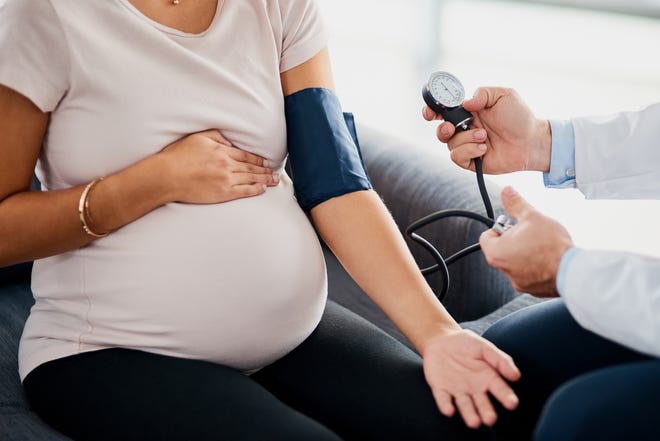Main reason for maternal mortality identified too late. Here is why.
A number one reason for maternal mortality typically goes unnoticed. By the point it is identified, it’s generally too late to stem the harm.
Medical doctors usually don’t establish preeclampsia, a severe type of hypertension developed throughout being pregnant, till blood stress and urine checks are so pronounced that the situation has seemingly progressed, inflicting organ harm. When circumstances are detected this late, ladies typically find yourself going into preterm labor, leading to penalties for infants and moms.
Girls of shade, notably Black and Native ladies, are at a lot higher danger of getting the situation attributable to current well being points.
An initiative introduced this week goals to detect and deal with preeclampsia earlier. If preeclampsia will be curbed extra ladies will be capable of deliver their infants to time period. Remedy will be so simple as prescribing aspirin to cut back or stop the situation. Researchers additionally hope the initiative can spur new remedies.
Tania Kamphaus, director of metabolic issues on the nonprofit Basis for the Nationwide Institutes of Well being, famous that even with small preventative steps, “You can also make a dramatic distinction to (a) particular person’s life and the lifetime of the child.” If allowed to run its course properly, she stated, preeclampsia “impacts each mom and little one – and never simply throughout being pregnant or within the first yr after, for all times.”
Preventable deaths:CDC sounds alarm on pregnant ladies’s physician visits amid rise in maternal deaths

The Facilities for Illness Management and Prevention discovered 1,205 ladies died of maternal causes in 2021, up from 861 in 2020. Black ladies died at greater than twice the speed of white ladies. The CDC has additionally decided that greater than 80% of pregnancy-related deaths are preventable.
Almost a 3rd of pregnant individuals who died throughout supply had a hypertensive dysfunction, a class that features preeclampsia. Globally, between 10 and 15% of maternal deaths are brought on by preeclampsia and associated problems, in keeping with the nonprofit March of Dimes. Preeclampsia can even happen postpartum.
The situation usually kicks in after the primary 20 weeks of being pregnant, about halfway by way of the second trimester, the Mayo Clinic stated. Preeclampsia is commonly found by way of blood stress checks. It is also typically detected by way of urine checks that present a affected person has excessive protein ranges. Different signs embrace decreased platelet ranges within the blood, elevated liver enzymes, extreme complications, adjustments in imaginative and prescient, in addition to shortness of breath brought on by fluid within the lungs, higher stomach ache and nausea or vomiting.
Nonetheless, medical doctors have been restricted in detecting the situation in sufferers, typically solely discovering it when it is too late.
“Within the U.S., the best way to detect anyone’s danger of creating preeclampsia is solely scientific,” stated Dr. Garita Sharma, director of cardiovascular ladies’s well being and cardio-obstetrics at Inova Well being System, who has studied preeclampsia dangers in Black American populations. “We don’t have any validated checks that we will use very early in being pregnant, or possibly even early within the second trimester, to know anyone’s larger danger.”
Threat elements embrace having preeclampsia in a earlier being pregnant, in addition to continual hypertension, diabetes, kidney illness, weight problems and older maternal age, Sharma stated. Black ladies are at higher danger, along with Indigenous ladies. Girls of shade within the U.S. might have a better incidence of continual sicknesses which are thought of danger elements for the illness.
Preeclampsia, when untreated, can lead to organ harm and result in preterm delivery. In a while, ladies are at higher danger of coronary heart failure and coronary heart illness, Sharma stated.
Detecting markers for preeclampsia
The three-year venture, by the nonprofit that promotes NIH’s work, seeks to judge knowledge on two biomarkers, molecules indicating placental development issue (PlGF) and pregnancy-associated plasma protein-A (PAPP-A), that may assist inform if somebody has preeclampsia.
The venture will draw from Eunice Kennedy Shriver Nationwide Institute of Little one Well being and Human Growth (NICHD) knowledge on greater than 25,000 pregnancies within the U.S. and Canada that researchers say permits for an ethnically and racially various research group.
Lethal deliveries: How hospitals are failing new mothers, in graphics | USA TODAY
Aaron Pawlyk, chief of NICHD’s obstetric and pediatric pharmacology and therapeutics department, stated this was necessary, since current knowledge on how properly the biomarkers work have been generated in different international locations. The information would measure PlGF and PAPP-A in blood collected from sufferers in cohort research.
The presence of PlGF and PAPP-A does not imply a affected person had preeclampsia, however it could assist researchers establish sufferers at larger danger, Pawlyk stated.
As soon as these markers are detected, medical doctors might extra carefully monitor these ladies for adjustments in blood stress, prioritizing Doppler ultrasound checks to have a look at blood circulation, and blood work to have a look at liver enzyme ranges. That manner, Pawlyk defined, aspirin can be utilized earlier.
The last word objective of the venture is to get the Meals and Drug Administration to permit this sort of detection. If the FDA accepted it, the information can be publicly out there, permitting firms to develop diagnostic testing. Corporations might then supply checks for pregnant sufferers throughout their common bloodwork.
This might additionally assist develop remedies along with detection. Scientific trials have strict limits on utilizing pregnant ladies in testing, stated Kamphaus, of the inspiration. Earlier testing might doubtlessly develop higher remedies for preeclampsia.
Eduardo Cuevas covers well being and breaking information for USA TODAY. He will be reached at EMCuevas1@usatoday.com.
